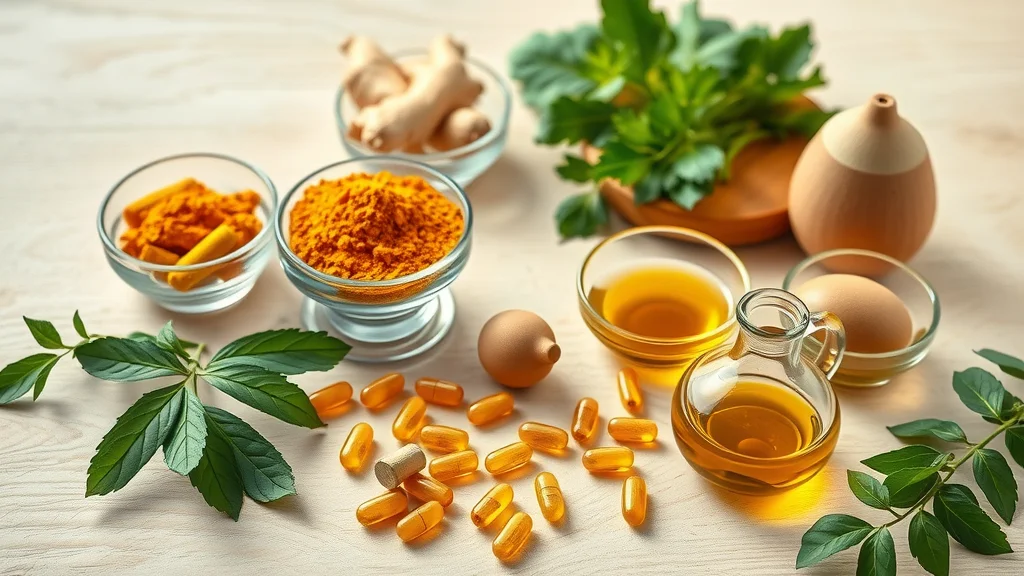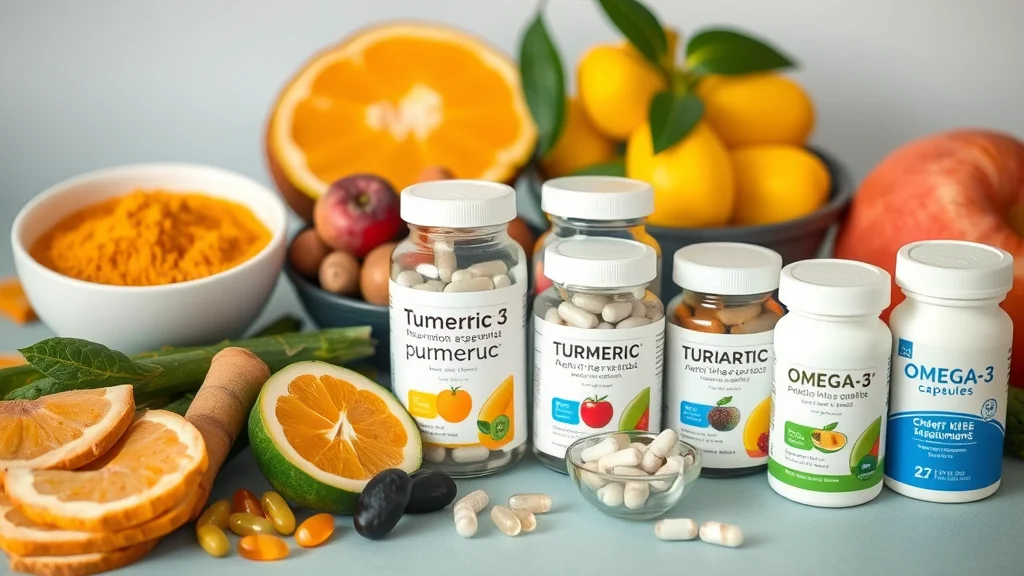Did you know? Up to 90% of aging-related diseases – including heart attacks, strokes, and even visible wrinkles – are linked to chronic inflammation. Understanding this connection could be the key to not just feeling younger, but looking younger, too. In this guide, you'll discover the practical actions you can take now to reduce inflammation, promote healthy aging, and lower your risk of chronic disease.
A Surprising Truth: How Reducing Inflammation Impacts Aging
"Up to 90% of aging-related diseases, including cardiovascular disease, are linked to chronic inflammation." – Harvard Medical School
When discussing aging, many assume it’s all about genetics and time. However, mounting evidence shows that chronic inflammation is the behind-the-scenes driver of both visible aging and long-term health problems. Reducing inflammation isn’t just about preventing aches or pains; it’s about protecting your entire body from the inside out. Everything from sagging skin and loss of energy to dangerous chronic conditions, such as cardiovascular disease and diabetes, can be traced back in part to unchecked inflammation. By learning how to reduce inflammation, you give your cells a fighting chance against the wear and tear of daily life — and potentially add healthy, vibrant years to your life.
Most people experience low-level inflammation without realizing it. This ongoing stress can gradually damage tissues, age skin, and silently raise the risk for chronic diseases long before symptoms become obvious. Tackling inflammation early with diet, habits, and other strategies is a science-backed way to maintain a healthier, more energetic body and a youthful appearance.
Why Reducing Inflammation Is Key to Longevity and Healthy Aging
Reducing inflammation is crucial for healthy aging because chronic inflammation silently accelerates the breakdown of your body’s tissues. Over time, this process damages cells and organs, causing them to function less efficiently. In the skin, for example, inflammation leads to a reduction in collagen, causing fine lines, wrinkles, and age spots to appear sooner. Inside your body, chronic inflammation promotes plaque buildup in arteries, increasing the risk of heart disease, and may even contribute to cognitive decline.
By understanding and addressing inflammation in your everyday life, you can slow these harmful effects—preserving both your appearance and overall health. Simple daily actions, from eating more fruits and vegetables to prioritizing restful sleep, all support your body’s natural anti-inflammatory defenses. This makes healthy eating and anti-inflammatory strategies a cornerstone of both longevity and feeling your best as you age.

What You’ll Learn About How to Reduce Inflammation and Aging
The connection between chronic inflammation, visible aging, and chronic disease
Actionable ways to reduce inflammation in the body
How diets like the Mediterranean diet and healthy eating combat chronic inflammation
Evidence-based natural tools to support anti-inflammatory actions
Understanding Inflammation in the Body: Acute vs. Chronic Inflammation
What Is Inflammation in the Body?
Inflammation in the body is a natural defense mechanism, triggered by your immune system to heal injury or infection. When your body senses a threat—like bacteria, viruses, or even a cut—immune cells release chemicals that improve blood flow and deliver nutrients to the affected area. This inflammatory response is essential for quick healing and fighting off invaders. In small doses, inflammation is beneficial and necessary.
However, problems arise when this reaction becomes too frequent or doesn’t shut down properly. Chronic or low-level inflammation keeps your immune system in a constant state of alert, leading to ongoing damage. This persistent state has been linked to everything from heart disease and diabetes to arthritis and visible signs of aging. Understanding the difference between helpful, short-term inflammation and harmful chronic inflammation is the first step to taking control of your health.
Acute Inflammation vs. Chronic Inflammation: What’s the Difference?
Acute inflammation is your body’s immediate, short-term response to injury or illness. Think redness and swelling after a sprained ankle or the warmth around a healing cut. This type of inflammation typically subsides within days, once the threat is gone and healing is underway. Acute inflammation is generally beneficial and a sign your immune system is working properly.
Chronic inflammation, on the other hand, is prolonged and low-level. It continues quietly inside the body for months or even years, often without noticeable symptoms at first. Instead of fighting off a clear threat, your immune cells mistakenly target healthy tissue, causing subtle but ongoing damage. This type of inflammation is now recognized by researchers as a major contributor to the development of chronic diseases, such as cardiovascular disease, diabetes, and even some cancers. Reducing chronic inflammation should be a priority to support your long-term well-being and visible youthfulness.
The Role of the Inflammatory Response in Aging
The body’s inflammatory response is a double-edged sword when it comes to aging. While acute inflammation is necessary for cell repair and defense, chronic or systemic inflammation accelerates the breakdown of tissues, leading to faster visible and internal aging. This process, sometimes called “inflammaging,” affects everything from the suppleness of your skin to the flexibility of your blood vessels and the sharpness of your mind.
As we age, the body’s control over inflammation tends to weaken. Older adults are more susceptible to low-grade, persistent inflammation due to factors like oxidative stress, unhealthy diet, and a less robust immune system. This makes it all the more important to intentionally reduce inflammation with smart lifestyle and dietary choices every day.
How Chronic Inflammation Accelerates Visible Aging and Chronic Disease
"Chronic inflammation is often called the 'silent killer' due to its subtle but damaging effects on skin, organs, and overall health." – Dr. Jane Smith, MD
Most people associate “aging” with wrinkles and gray hair. But what happens internally is even more important. Chronic inflammation acts as an invisible stressor, quietly impairing cells and tissues across your body. This kind of inflammation not only shows up as sagging skin and joint pain, but also sets the stage for chronic diseases like cardiovascular disease, diabetes, and neurodegenerative disorders. Many individuals don’t realize that what they eat, how much they move, and how well they sleep all affect systemic inflammation—making them either more resilient or more vulnerable to illness and premature aging.
By focusing on how to reduce inflammation throughout your daily life, you directly impact your likelihood of living longer, looking younger, and feeling more energetic. This section will break down the science and practical ways to manage and minimize chronic inflammation for overall wellness.
Chronic Inflammation and Aging: Mechanisms Explained
At a cellular level, chronic inflammation accelerates aging by creating oxidative stress and damaging DNA. Immune cells kept in a constant state of alert produce free radicals, which attack healthy tissue. Over time, this degrades collagen and elastin in the skin—manifesting as wrinkles and loss of firmness. Systemically, chronic inflammation interferes with insulin sensitivity, triggers unhealthy fat storage, and increases the risk for hardening of the arteries.
The “silent” aspect of chronic inflammation is what makes it so dangerous. Early on, you may not notice any symptoms. But year after year, this internal wear and tear builds up, shortening telomeres (the protective ends of chromosomes), and promoting the development of chronic diseases. Research shows that people with higher levels of inflammatory markers age more quickly and are more likely to suffer from conditions such as arthritis and heart disease.

How Chronic Inflammation Leads to Chronic Diseases
Chronic inflammation doesn’t just age your skin—it harms your internal organs, too. The constant, low-level attack on blood vessels can cause them to stiffen and narrow, increasing the risk of cardiovascular disease and high blood pressure. Similarly, chronic inflammation in joints damages cartilage, leading to painful conditions like osteoarthritis. In the gut, it disrupts digestion and nutrient absorption, potentially leading to inflammatory disease diagnoses, including Crohn’s and ulcerative colitis.
Meanwhile, the immune system’s misguided actions can target even the brain, raising the risk of cognitive decline and memory problems as you age. This comprehensive damage underscores the critical importance of daily steps to reduce inflammation and build resilience against chronic diseases.
The Link Between Inflammation, Cardiovascular Disease, and Visible Aging
The connection between inflammation and cardiovascular disease is well-established. Inflammatory markers like C-reactive protein rise when your arteries are being damaged, often years before a heart attack or stroke occurs. Similarly, inflammation plays a role in raising blood pressure, a major risk factor for heart-related complications.
On the outside, these same inflammatory processes lead to slower skin repair, breakdown of collagen, and the appearance of dark spots and fine lines. Studies have shown that people with persistently elevated inflammation not only have a higher incidence of heart disease, but also display more rapid signs of aging. Controlling inflammation means you’re supporting not just a longer life, but also a more vibrant one—inside and out.
Dietary Strategies to Reduce Inflammation: Mediterranean Diet, Healthy Eating, and More
The Mediterranean Diet: A Proven Way to Reduce Inflammation
The Mediterranean diet is globally recognized for its ability to reduce inflammation and extend lifespan. Rich in fruits, vegetables, whole grains, legumes, nuts, and especially olive oil, this pattern of eating provides powerful antioxidants and healthy fats that limit the body’s inflammatory response. Unlike the typical Western diet—high in processed foods, refined grains, and added sugar—the Mediterranean approach is low in saturated and trans fats, both of which are known to increase systemic inflammation.
Olive oil, at the heart of the Mediterranean diet, delivers oleocanthal—an anti-inflammatory compound similar in action to ibuprofen. Fatty fish, such as salmon and sardines, provide omega-3 fatty acids, another potent way to reduce inflammation. Studies have shown that consistent adherence to this style of healthy eating can decrease the risk of cardiovascular disease, cognitive decline, and even some forms of cancer, all while supporting youthful skin and energy.
Comparison of Anti-Inflammatory Diets: | ||
Diet |
Main Features |
Inflammation Impact |
|---|---|---|
Mediterranean Diet |
Olive oil, fruits, vegetables, whole grains, fatty fish, nuts, moderate red wine |
Reduces chronic inflammation, improves heart & overall health |
Inflammatory Diet |
High in processed foods, added sugar, fried foods, red meat, |
Promotes systemic inflammation, increases risk of chronic disease |
Western Diet |
Refined grains, sugary drinks, red and processed meats, low fiber |
Strongly linked to high inflammation and visible aging |

Key Foods That Reduce Inflammation: Fruits, Vegetables, and Olive Oil
The cornerstone of any anti-inflammatory diet is an abundance of fruits and vegetables. These are dense in antioxidants—molecules that neutralize free radicals, helping to both protect and repair body cells. Berries, leafy greens, tomatoes, and citrus fruits are especially rich in anti-inflammatory nutrients. Whole grains such as oats and quinoa also provide fiber, which supports gut health and reduces inflammation in the body.
Olive oil deserves special mention: it’s loaded with beneficial polyphenols that act as natural anti-inflammatories. Nuts (especially walnuts and almonds), seeds, and fatty fish all supply essential fats needed to balance the body’s inflammatory response. For best results, aim to fill half your plate with colorful plant foods at every meal, drizzle salads with extra-virgin olive oil, and swap red meat for fish or plant proteins often.
Healthy Eating Habits to Reduce Inflammation
Eating well is about more than single foods—it’s about habits. Try to limit your intake of high-glycemic foods (like white bread and sugary snacks) that spike blood sugar and fuel inflammation over time. Instead, choose high-fiber, nutrient-rich foods that keep your energy steady and your gut healthy. Drink enough water, eat mindfully, and avoid overeating, which can place additional stress on your immune system.
It’s also smart to space your meals, allowing your digestive system proper rest, and to consider adding herbs and spices like turmeric and ginger to your cooking—they have natural anti-inflammatory properties. Embracing these healthy eating habits daily builds a strong foundation for reducing inflammation and enjoying long-term health benefits.
Inflammatory Foods to Avoid: Processed Foods and Inflammatory Diet Patterns
Processed foods and their impact on inflammation in the body
How an inflammatory diet triggers chronic inflammation
Worst culprits: processed food, sugar, and trans fats
Limiting processed foods is one of the fastest ways to reduce inflammation. Packaged snacks, fast food, processed meats, and sweetened beverages are filled with added sugar, salt, unhealthy oils, and preservatives. These ingredients disrupt normal metabolic processes, overstimulate the immune system, and create toxic byproducts that build up in tissues.
An inflammatory diet—one that's high in fried foods, refined grains, red meat, and trans fats—produces ongoing stress in the body. It raises systemic inflammation and increases the risk of developing chronic diseases such as diabetes, cardiovascular disease, and obesity. The worst offenders include deep-fried treats, sugary breakfast cereals, soft drinks, and highly processed baked goods. Making a conscious effort to cut back on these foods supports the immune system and helps slow visible aging.

Natural Lifestyle Approaches to Reduce Inflammation in the Body
Exercise and Its Anti-Inflammatory Benefits
Regular exercise plays a remarkable role in lowering chronic inflammation. Physical activity improves blood flow, boosts antioxidant defenses, and helps regulate stress hormones—all of which protect cells from inflammatory damage. Even moderate movement, like brisk walking or yoga, signals your body to dial down inflammatory chemicals. Consistent exercise reduces the risk of chronic diseases and supports a healthier body composition, which further diminishes inflammation.
Importantly, you don’t have to be a marathon runner to see results. Aim for 30 minutes of activity most days of the week—whether it’s dancing, gardening, swimming, or cycling. The health benefits of regular movement are clear: improved mood, sharper memory, healthier joints, and more radiant skin over time.

Stress, Sleep, and Their Effects on Chronic Inflammation
Chronic stress and poor sleep are silent enemies of your health. When you’re stressed, your body produces cortisol and other chemicals that can increase inflammation, especially if stress is ongoing. Over time, this can undermine your immune system’s balance, slow healing, and accelerate visible aging.
Similarly, getting less than seven hours of restful sleep per night increases inflammatory markers such as C-reactive protein. Developing a calming evening routine, practicing mindfulness or meditation, and setting regular sleep times can help. Even small improvements, like taking brief walks outdoors or practicing deep breathing, can make a noticeable difference.
"Even small lifestyle changes, like moving more and sleeping better, can substantially reduce inflammation in the body."
Supplements and Natural Anti-Inflammatory Compounds
While lifestyle is foundational, supplements and natural remedies can play a supportive role in reducing inflammation. Popular evidence-backed choices include omega-3 fatty acids (from fish oil or algae oil), turmeric (curcumin extract), ginger, green tea extract, and resveratrol. These compounds fight inflammation by targeting specific pathways that cause immune overactivity.
Before starting any supplement, check with your doctor, especially if you’re taking medications or have a health condition. Remember, supplements work best as part of a holistic approach alongside a healthy diet, regular activity, stress management, and adequate sleep.

Reducing Inflammation: Frequently Overlooked Habits and Expert Tips
Breaking habits that worsen chronic inflammation
Simple swaps to support an anti-inflammatory lifestyle
Expert recommendations for long-term success
Some everyday habits quietly add to chronic inflammation—like sitting for hours without moving, skipping meals, or consuming rich foods late at night. Smoking, excessive alcohol, and high stress also fuel the fire. One overlooked yet effective change is practicing mindful eating: chew slowly, savor meals, and pause between bites to support proper digestion.
Swap out processed snack foods for fresh fruit, trade soda for water infused with lemon, and keep healthy snacks—like nuts and seeds—on hand. Living an anti-inflammatory lifestyle is not about perfection. Start with easy, sustainable shifts, and build momentum. Experts agree: consistency beats intensity for reducing inflammation and achieving lasting health.
Watch our curated guide to the top five anti-inflammatory foods to easily add to your weekly meals, helping you reduce inflammation naturally and deliciously.
People Also Ask: Reducing Inflammation and Aging
What is the fastest way to reduce inflammation in the body?
A review of quick anti-inflammatory strategies, from dietary changes to lifestyle hacks.
The fastest way to reduce inflammation in the body is by making immediate dietary changes: removing processed foods, sugars, and fried foods while increasing your intake of fruits and vegetables, nuts, and olive oil. Even a single meal swap—from processed convenience food to a colorful salad with salmon—can start reducing your body's inflammatory signals within hours. Other quick strategies include hydrating well, taking a brisk walk, prioritizing sleep, and practicing deep breathing to lower stress quickly. Altogether, these simple changes have a rapid impact on inflammation markers and how you feel.
What is the #1 habit you should break if you have inflammation?
Exploring critical habits that perpetuate chronic inflammation and how to change them.
The #1 habit to break is regularly consuming processed food—these items contain added sugars, unhealthy fats, and chemical preservatives that increase systemic inflammation. Start by cutting back on soda, packaged snacks, and fast food. Instead, prepare more meals at home using whole, unprocessed ingredients and swap sweets or chips for fruit or nuts. Over time, taste preferences adjust and cravings for inflammatory foods fade, making healthier habits easier to maintain and supporting lower inflammation for the long haul.
What is the strongest natural anti-inflammatory?
Insight into leading natural remedies—like turmeric and omega-3s—to reduce inflammation.
Turmeric (curcumin) and omega-3 fatty acids (from fatty fish, flaxseed, and walnuts) are among the strongest natural substances for reducing inflammation in the body. Curcumin acts to block inflammatory pathways at the cellular level, while omega-3s balance immune activity and reduce inflammatory chemicals. Incorporating these into your daily diet—either through cooking or high-quality supplements—can amplify the body’s anti-inflammatory capacity and protect against chronic diseases.
How to decrease inflammation in children?
Best practices for reducing inflammation in children, including dietary and lifestyle guidance.
Reducing inflammation in children starts with a diet focused on whole foods—lots of colorful vegetables, fruit, whole grains, and clean proteins. Limit sugar-sweetened beverages, fast food, and processed snacks, which are major sources of added sugar and trans fat. Encourage physical activity, good sleep habits, and adequate hydration. For kids with recurring inflammation or specific health conditions, consult a doctor or nutritionist for tailored advice, but in general, a healthy diet and lifestyle are the best foundational tools for reducing inflammation in younger ages.

Frequently Asked Questions About How to Reduce Inflammation
Does reducing inflammation reverse aging?
Reducing inflammation doesn’t literally reverse aging, but it does slow the internal and external processes that accelerate signs of aging—helping you look and feel younger for longer.Can you see visible changes after reducing inflammation?
Yes, many people notice improvements in their skin, energy, and even joint comfort after adopting anti-inflammatory habits. Clearer skin, fewer flare-ups, and improved well-being are common.What is the role of antioxidants in an anti-inflammatory diet?
Antioxidants help neutralize free radicals, which are unstable molecules that worsen inflammation. By eating foods high in antioxidants, you’re offering your body extra defense against cellular damage.Are there risks to overly restricting inflammatory foods?
Moderation is key. While reducing sugary, fried, and processed foods is good, an overly restrictive approach may lead to nutritional gaps or disordered eating. Consult a nutritionist for a balanced plan if needed.
Key Takeaways: The Path to Reduce Inflammation and Age Gracefully
Adopting an anti-inflammatory lifestyle slows visible aging and lowers chronic disease risk
Mediterranean diet and healthy eating choices are foundational to reducing inflammation
Avoiding inflammatory foods and managing stress are critical
Summary and Next Steps for Reducing Inflammation and Supporting Healthy Aging
Reducing inflammation is a cornerstone of healthy aging. Begin today by eating more whole foods, moving more, sleeping well, and discovering the benefits of a Mediterranean-inspired diet. The path to vitality starts with your next choice!
 Add Row
Add Row  Add
Add 




Write A Comment